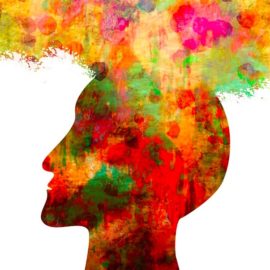
What exactly makes insight different from ordinary learning? How can understanding these differences help us experience more breakthrough moments in our thinking?
In his book Seeing What Others Don’t, Gary Klein identifies three key characteristics of insight and debunks three common myths. Understanding what insight is helps us recognize when we’re experiencing genuine breakthroughs and creates conditions where insights are more likely to occur.
Keep reading to learn what insight is and what it isn’t.
Characteristics of Insight: What Insight Is
Before we can learn how to have more insights, we need to understand exactly what they are—and what makes them different from ordinary learning or problem-solving. Klein identifies three characteristics of insight: It represents a leap in logic rather than adding to our previous understanding, it contradicts something we previously believed or assumed, and it’s deeply personal.
Characteristic #1: Insights Are Discontinuous Leaps
Unlike step-by-step learning, insights represent sudden jumps in understanding. Klein explains that insights don’t build gradually on what we know; instead, they fundamentally reshape our perspective. For example, when Isaac Newton developed his laws of motion and gravity, he didn’t merely refine existing theories: He created an entirely new way of understanding how the universe works.
Klein notes that this discontinuous nature explains why insights often feel like they arrive fully formed, rather than through conscious reasoning. They represent not just new information, but an entirely new framework for understanding. It’s like suddenly seeing a 3D image emerge from what previously looked like random patterns: Once you see it, you can’t unsee it, and your understanding is permanently transformed.
| How Insights Have Transformed the Way Physicists Understand the Universe Physicist Michael Dine explains in This Way to the Universe that each major breakthrough in physics, like Newton’s insights about motion and gravity, came when scientists stopped trying to fit new observations into old frameworks and instead embraced entirely new paradigms. Newton couldn’t just add mathematical laws to a universe governed by divine whim: He had to see the cosmos as fundamentally mathematical. Similarly, scientists Michael Faraday and James Clerk Maxwell—who discovered the electromagnetic field—couldn’t just add fields to a world where forces acted through contact: They had to reimagine space as filled with invisible influences. Albert Einstein couldn’t just modify how time worked: He had to reconceptualize space and time as aspects of a single fabric, leading to the theory of relativity. These insights couldn’t have been reached through incremental steps. You either see the universe as mathematical or you don’t; you either understand space as filled with fields or you don’t; you either grasp the unity of space-time or you don’t. Once these scientists saw their new frameworks for understanding, they couldn’t unsee them—and neither could the scientific community, once they grasped the full implications of these revolutionary ways of seeing. |
Characteristic #2: Insights Challenge Our Mental Models
Insights are powerful—and often uncomfortable—because they contradict our current understanding. Klein explains that insights don’t simply add new information to what we already know; instead, they require us to admit that our existing beliefs or assumptions are incomplete or wrong. This can feel destabilizing because we have to let go of familiar ways of thinking and embrace new paradigms that better explain what we observe. Often, the more fundamental the belief being challenged, the more resistant we might be to accepting the insight—even when the evidence supports it.
Klein explains that Dr. Michael Gottlieb’s discovery of AIDS illustrates this challenging of mental models. When Gottlieb encountered patients with severe immune deficiencies that couldn’t be explained by any known condition, he faced a choice: try to force these observations to fit existing medical frameworks, or accept that he was seeing something entirely new. By being willing to discard old assumptions about how immune diseases worked, he recognized that he was witnessing the emergence of a new disease—a realization that transformed our understanding of immune disorders and viral infections.
| What Makes Existing Mental Models Powerful—and Dangerous—in Medicine Gottlieb’s insight about AIDS demonstrates both the importance of challenging existing mental models and the devastating consequences when institutional biases prevent such challenges. His willingness to question established understanding led to the identification of a new disease, but the medical establishment’s response to his discovery reveals how deeply entrenched mental models can delay us from taking action based on lifesaving insights. Even after Gottlieb’s discovery, many health-care professionals initially dismissed or minimized the crisis because it didn’t fit the existing frameworks that structured their knowledge: Social bias: Because early cases appeared primarily in gay men, many doctors assumed the condition was linked to lifestyle choices rather than a pathogen, scapegoating the LGBTQ community and delaying crucial research. Institutional inertia: Though Gottlieb discovered AIDS in 1981, it wasn’t until 1985 that President Reagan publicly addressed AIDS, partly because the crisis didn’t fit existing models of how public health emergencies should look or be handled. By that time, more than 12,000 Americans had died. Research frameworks: Early research was hampered by erroneous assumptions about how diseases spread, leading to missed opportunities to understand transmission patterns. While Gottlieb’s insight that AIDS was a new disease was crucial, it took years of pressure from activist groups to force medical and governmental institutions to abandon their biased mental models and respond appropriately to the crisis. Today, HIV/AIDS treatment and prevention showcase how transformative it can be when institutions finally do update their mental models. The development of effective treatments, the recognition that “Undetectable = Untransmittable,” and the creation of pre-exposure prophylaxis (PrEP) all required doctors and researchers to challenge their previous assumptions about how the disease could be managed and prevented. |
Characteristic #3: Insights Are Personally Transformative
While multiple people might have access to the same information, insights are deeply personal revelations. They change not just what we know, but how we think about a problem. This is why two scientists can look at the same data and come to radically different conclusions: Each person’s insight transforms their individual understanding.
The personal nature of insights explains why they often provoke strong emotional reactions, from excitement to disbelief. When we gain an insight, we’re not just learning new information—we’re experiencing a fundamental shift in how we see the world. This transformative quality is what makes insights so powerful: They don’t just solve problems, they change the problem-solver. Once we’ve had an insight, we can’t go back to our previous way of thinking, even if we wanted to.
| The Power of Paradox: Zen Buddhism and Insight Klein’s three characteristics of insight—that they represent discontinuous leaps in understanding, contradict our previous beliefs, and are deeply personal—align with how Zen Buddhism approaches transformative realizations through koans, paradoxical questions designed to short-circuit our usual ways of thinking. Consider the famous koan, “What is the sound of one hand clapping?” When students embrace the uncertainty of contemplating this seemingly nonsensical question, they experience all three characteristics Klein identifies: • You either “get” a koan or you don’t—there’s no gradual path to understanding. As Zen teacher Philip Kapleau explains, the purpose of a koan is actually to “make us lose our way and drive us to despair,” creating the conditions for a sudden breakthrough in understanding. Once this breakthrough occurs, just as Klein notes about insights, there’s no going back: A student who truly understands a koan can never return to their previous way of seeing it. • Koans deliberately challenge our usual ways of thinking. When a monk asked a Zen master if dogs have Buddha-nature and received the reply “Mu!” (meaning “nothing”), the apparent nonsense of the answer forces the student to abandon familiar frameworks for making sense of questions and answers. • While many students might hear the same koan, each person’s understanding is unique. As philosopher Alan Watts (The Way of Zen) notes, understanding the koan requires “going down into one’s own inner, secret place” rather than following others’ paths.This suggests that Klein’s framework for cultivating insights isn’t just a modern discovery but reflects deeper truths about how humans achieve breakthrough understanding. Whether through Buddhist meditation, artistic creation, or scientific discovery, genuine insights seem to require us to move beyond our usual patterns of thought and embrace uncertainty. |
Common Myths About Insight: What Insight Isn’t
Klein’s research debunks some persistent myths about how insights work. He explains that understanding these misconceptions is crucial because they might be holding you back from recognizing or acting on potential insights.
Myth #1: Insights Always Come as “Aha!” Moments
We love stories about sudden breakthroughs—Newton’s apple, Archimedes’s bathtub—but Klein’s research shows that insights often develop gradually. Charles Darwin’s insight about natural selection, for instance, emerged over years of careful observation and incremental understanding. Both sudden and gradual insights can be equally valuable, so Klein points out that it’s key to remain open to both.
Myth #2: You Must Prepare for Insights to Arrive
The traditional model of creative insight, developed by Graham Wallas in 1936, suggests that breakthroughs follow a fixed sequence: preparation, incubation, illumination, and verification. While this can happen—especially in the creative desperation path—Klein found that many crucial insights arrive without any conscious preparation. Alexander Fleming wasn’t trying to discover antibiotics when he noticed the bacteria-free zone around some mold in his petri dishes. But his openness to the unexpected proved incredibly valuable, perhaps more valuable than preparation could have been in that scenario.
Myth #3: Insights Come Only Through Deep Focus
While focused work is valuable, Klein’s research shows that insights often arrive when we’re not consciously working on a problem. He explains that sometimes, stepping away from intense concentration creates space for new connections or perspectives to emerge. This explains why solutions often pop into our heads during a shower or walk. However, he points out that this doesn’t mean we should wait passively for insights to arrive.
| The Reality of Insight: Lessons From A Beautiful Mind The story of mathematician John Nash, portrayed in the 2001 film A Beautiful Mind, illustrates how Klein’s research debunks the three common myths about insight. While the Hollywood version necessarily dramatizes some “eureka” moments (like Nash’s breakthrough about game theory coming to him while watching his friends compete for a woman’s attention in a bar), the real Nash’s journey shows how insights actually work: Nash’s most important insights about equilibrium theory developed gradually over years. His early work on bargaining problems slowly evolved into his revolutionary insights about non-cooperative games. Like Darwin’s understanding of natural selection, Nash’s greatest contributions came through patient observation and incremental understanding, not just sudden flashes of inspiration. Additionally, some of Nash’s most important insights came when he wasn’t deliberately working toward them. His insights about governing dynamics emerged partly from observing everyday human behavior—like watching people navigate through crowds—rather than from formal mathematical preparation. Nash’s ability to see mathematical patterns in daily life didn’t rely on constant focused effort—though it could have been related to his schizophrenia.Nash’s story reminds us that real insight often looks different from our dramatic expectations. Like Klein’s research subjects, Nash found breakthrough ideas in various ways: sometimes gradually, sometimes without preparation, and often when his mind was free to make unexpected connections. |





